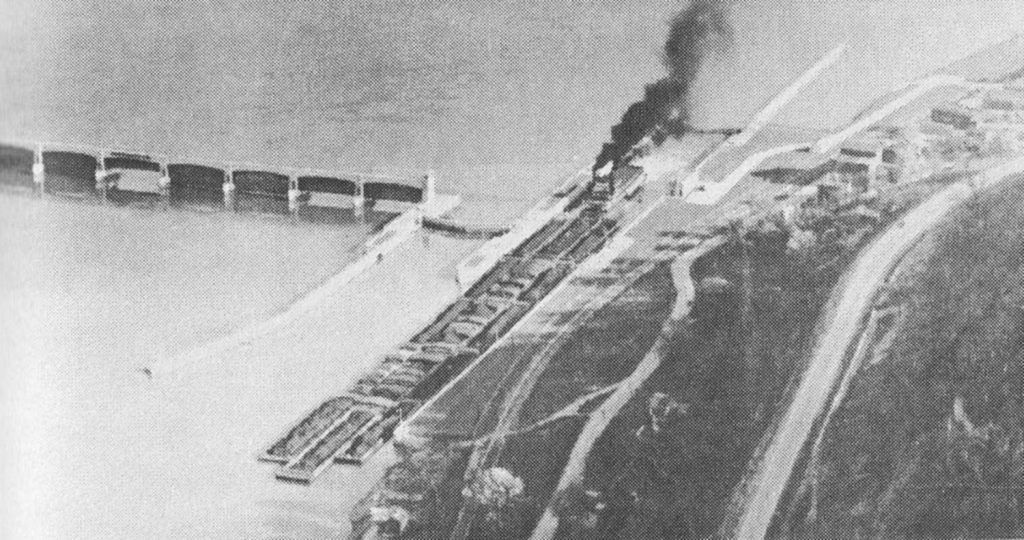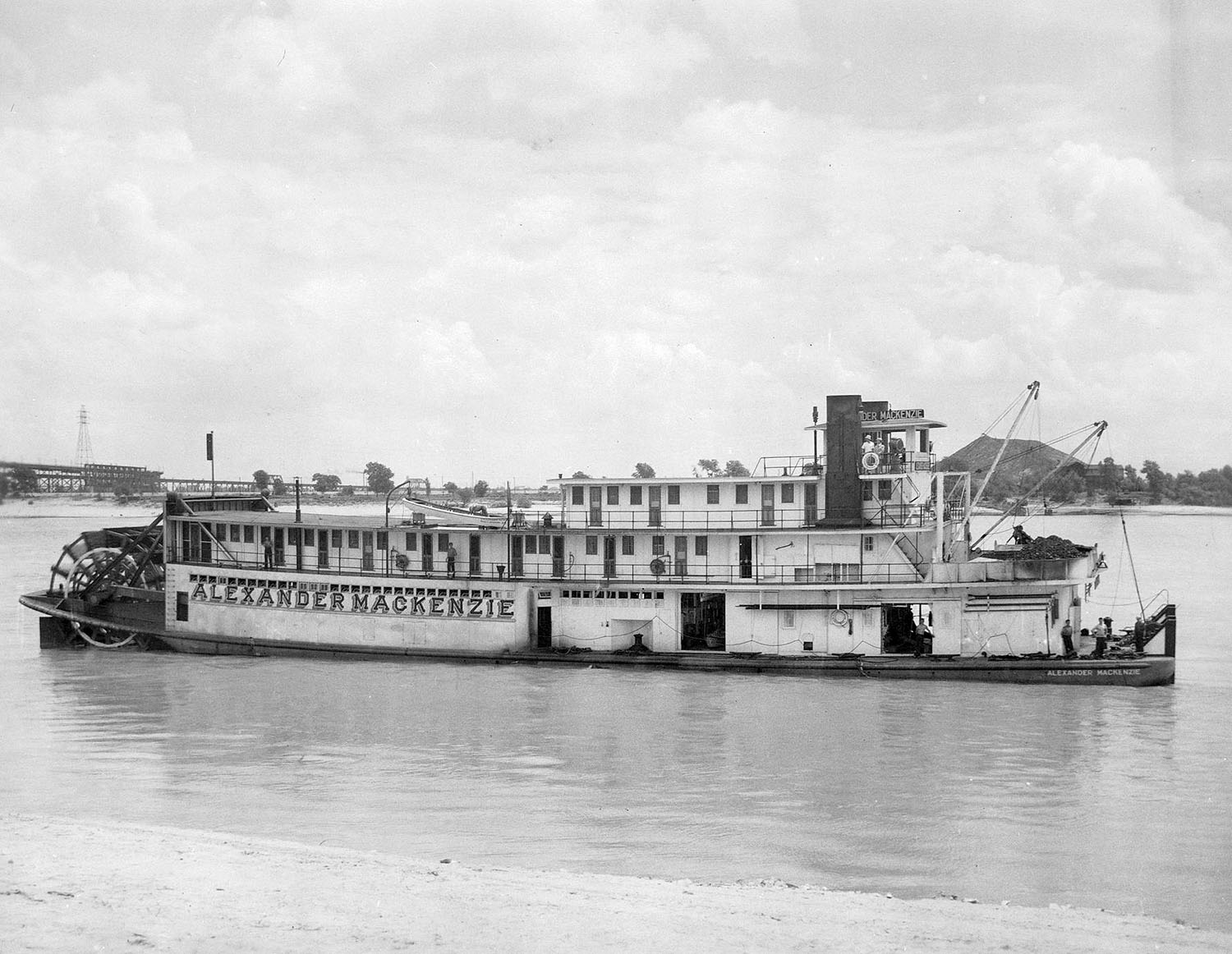The August 6, 1938 issue of The Waterways Journal carried a small story on page 5 concerning A.C. Ingersoll accepting a position with a new company on the Illinois and Mississippi rivers. This new concern was the Central Barge Company, with offices in Chicago, and Ingersoll would be managing the operations. He had previously been a vice president of The Ohio River Company at Cincinnati. His son, Capt. A.C. Ingersoll Jr., had resigned his “berth” on The Ohio River Company steamer E.D. Kenna to accept a position with Central. A story on the same page detailed the early success of the new Standard Oil towboat Jack Rathbone (WJ August 21, 2023).
In the August 20, 1938, issue of the WJ was a news story about the new Central Barge Company inviting bids to build two steam sternwheel towboats of 1,500 hp. and a fleet of 32 barges. The boats were to be “of the Jack Rathbone type as built by the Marietta Manufacturing Company,” and the hopper barges were to be 195 feet long, 35 feet wide and 11 feet in depth. The boats would be expected to tow out of St. Louis to the Upper Mississippi River and would be slightly shorter than the Rathbone due to the locks that they would encounter. Even though most new boats were being built diesel-powered, Central would be engaged in towing coal northbound, and for real push power, steam was still considered the way to go.
The October 8, 1938, issue of the WJ again carried news about Central Barge Company. This time the story was that Central had awarded a contract to the Marietta Manufacturing Company (MMC), Point Pleasant, W.Va., for the construction of a steam sternwheel towboat with a hull 168 by 37 feet. It was to be powered with Marietta piston poppet valve compound engines that would be 16’s, 32’s – 10-foot stroke. It would be equipped with Foster-Wheeler water tube boilers, automatic stokers and special coal handling buckets to move coal from fuel flat to bunkers. Work on the boat was to begin immediately with a delivery date by May 15, 1939. The boat would have a longer texas cabin than the Jack Rathbone and was to have only one smokestack behind the pilothouse.
Announcement was made in the December 17, 1938 WJ that Central had purchased the twin screw diesel towboat W.A. Shepard from American Barge Line. The 1,350 hp. vessel was a near duplicate of the Geo. T. Price (WJ, April 21, 2021) and had been built by Ward at Charleston, W.Va., in 1927. This purchase may be why Central ultimately had only one steam towboat built, rather than the two that had been announced in August.
The Point Pleasant Register of January 24, 1939, stated that the name of the new Central Barge Company boat under construction at MMC would be Alexander Mackenzie. Brig. Gen. Mackenzie (1844-1921) had been the Rock Island District Engineer for 16 years, and as such oversaw the construction of wing dams (dikes) on more then 100 miles of the Upper Mississippi River to ensure a navigable channel. In 1895, he became the assistant to the Chief of Engineers in Washington, D.C., and oversaw all matters relating to river and harbor improvements. The Register story also said that the engines on the boat would be ready for testing within 30 days, that launching was to take place in late March or early April and delivery to the owners was scheduled for June.
The Alexander Mackenzie, which had been designed by Floyd Alexander, was completed on schedule and according to the Cincinnati news column of the June 3, 1939 WJ it was at the Greene Line wharfboat on May 31, where a trove of interested river personages visited aboard. The steamers Island Queen, Gordon C. Greene and Tom Greene had saluted the new boat as it arrived, and at 2:30 p.m. it was back under way downbound, headed for the Illinois and Upper Mississippi Rivers. Capt. A.C. Ingersoll, Jr. was master, with Capts. Rolla “Dusty” Rogers and Howard West, pilots. Carl Hall, Lonnie Laughlin and Norman Davis were the engineers and Ellis Robinson was mate. Despite the fact that the early specs for the boat had called for only one smokestack, there were in fact two, but they were neither forward nor behind the pilothouse. The stacks were positioned one on each side of the pilothouse, near the after corners of that structure.
The Upper Mississippi news column of the June 17, 1939 WJ gave a vivid description of the power of the Mackenzie. “Making more speed upstream with its heavy tow than anticipated, the new steamer Alexander Mackenzie locked through the Rock Island locks about 8 a.m. Monday.” The boat had 10 loaded barges in tow at the time, “the largest tow to come this far upstream and the largest to negotiate the local locks.” The big boat would go on to replicate such feats.

Capt. Norman Hillman mentions his time aboard the Mackenzie extensively in his “One Man and the Mighty Mississippi.” He was aboard as steersman and pilot and would go on to serve as one of, if not the last, master of the boat. Hillman related to me that the company once wanted him to coal the boat at Cairo and try to make it to St. Louis without dragging a fuel flat alongside, theorizing that better time could be made that way. He said they did make it, but “we were sweeping up dust to throw in the firebox by the time we got there. I never did that again!”
In July 1952, Central Barge was absorbed into the Mississippi Valley Barge Line. In August of that year, the Mackenzie was brought to Cincinnati and laid up. By this time Valley had several diesel prop boats equipped with kort nozzles that were in the 3,000 hp. range. This included the former steam prop Indiana and Louisiana. Ashland Oil & Refining Company had recently placed in service what at the time were the most powerful towboats in the country, the triple screw 4,800 hp. Aetna-Louisville and Allied-Ashland. Steam sternwheel power was on the wane.
MMC had built a near duplicate to the Mackenzie named Jason in 1940 that was owned by Union Barge Line until sold in 1951 to Amherst Barge Company and renamed Herbert E. Jones. In 1954, an engine on the Jones “ran through itself,” where the piston came through a cylinder head, and a crank was broken off of the sternwheel shaft. Amherst purchased the machinery of the Mackenzie, towing it from Cincinnati to Port Amherst on the Kanawha for dismantling. After repairs were made, the Jones towed the Mackenzie back to the Valley Line landing at Cincinnati.
The Alexander Mackenzie, minus the machinery, was eventually taken to Joliet, Ill., where the Valley Line used it as a shop barge. The stacks and pilothouse were gone, but one could get a glimpse of the boat as it had been. At last track this writer had it was still at that location.
Caption for top photo: The Alexander Mackenzie soon after entering service in 1939. This photo was often used in MMC ads in the WJ. (David Smith collection)
Capt. David Smith can be contacted at davidsmith1955obc@gmail.com.




